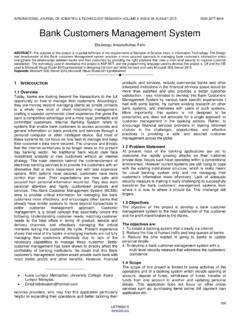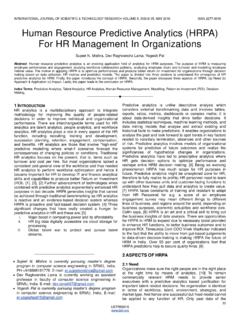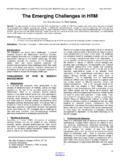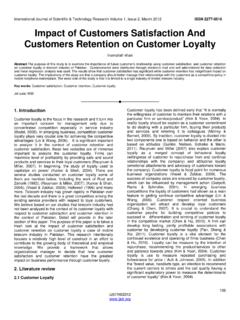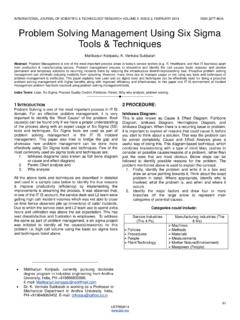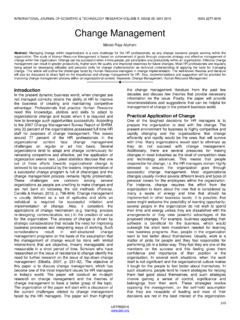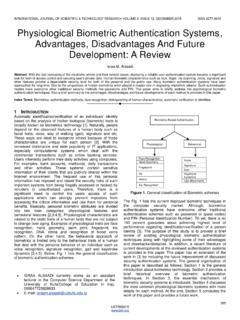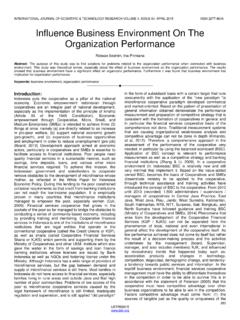Transcription of INTERNATIONAL JOURNAL OF SCIENTIFIC & TECHNOLOGY …
1 INTERNATIONAL JOURNAL OF SCIENTIFIC & TECHNOLOGY RESEARCH VOLUME 4, ISSUE 08, AUGUST 2015 ISSN 2277-8616 222 IJSTR 2015 project Planning And scheduling Using PERT And CPM Techniques With Linear Programming: Case Study Wallace Agyei Abstract: Completing a project on time and within budget is not an easy task. project planning and scheduling plays a central role in predicting both the time and cost aspects of a project . This study is aimed at finding trade-off between the cost and minimum expected time that will be required to complete the building project . The data on the cost and duration of activities involved were obtained Angel Estates and Construction Ltd., a construction company based in Ashanti region, Ghana. Both critical path method (CPM) and project evaluation and review technique (PERT) were used for the analysis. The activities underwent crashing of both the time and cost using linear programming, this paved way for the determination of critical path.
2 Further analysis revealed that the shortest possible time for the completion of the analyzed building project is 40 days instead of the expected duration of 79 days. This means that through proper scheduling of activities, the expected completion time was reduced by 39 days. The additional cost associated with the reduction in timing is GH 1, which increases the initial expected cost required to complete the project from GH 57, to GH 59, Keywords: Construction planning, Critical Path Method, project Evaluation and Review Technique, Linear programming, crashing. 1. INTRODUCTION Completing a project on time and within budget is not an easy task. In spite of advances in the field of project management today, most projects in Ghana today face cost and time over-runs which increases with the increase in complexity of the project involved.
3 A large number of factors contribute to delays that comprise primarily of contractor delays, client delays, consultant delays, labor related delays and various other external delays. These delays in long run causes time overrun, cost overrun, dispute, arbitration, total abandonment and litigation. This is because some project activities are critical in the sense that delay in their commencement will delay the overall project completion time. Therefore proper planning and scheduling of project is important to overcome this problem. A project can be defined as a set of a large number of activities or jobs that are performed in a certain sequence determined logically or technologically and it has to be completed within a specified time and cost whilst meeting the performance standards. The project could be the development of a software program, the building of a house or an office building, development of a new drug, a marketing campaign for a new product, and many others.
4 Network models are conventional means of finding the most skilful way to link a number of activities directly or indirectly in order to satisfy supply and demand requirements at different activity locations and project scheduling . For many years, two approaches that have been proven to be useful for planning, scheduling and controlling construction projects have been the Critical Path Method (CPM) and the project Evaluation and Review Technique (PERT).These techniques enables project managers to evaluate the early and late times at which activities can start and finish, calculate activity float (slack), define critical activities, and evaluate the impact of changes in duration, logical relations and cost on the overall project duration. Both CPM and PERT are network based techniques and therefore help in programming and monitoring the progress of the stages involved so that the project is completed within the deadline.
5 In doing this, it specifies the part of the project that are crucial which if delayed beyond the normal time would increase the completion time of the project as a whole. It further assists in allocating resources, such as labor and equipment and thus helps to make the total cost of the building project a minimum by finding the optimal trade-off between various costs and time involved [1]. Although PERT and CPM differ to some extent in terminology and in the construction of the network, their objectives are the same. Furthermore, the analysis used in both techniques is very similar. The major difference is that, in CPM activity times are assumed proportional to the amount of resources allocated to them, and by changing the level of resources the activity times and the project completion time can be varied.
6 Thus CPM assumes prior experience with similar projects from which the relationships between resources and job times are available. On the other hand, PERT incorporates uncertainties in activity times in its analysis. It determines the probabilities of completing various stages of the project by specified deadlines. It also calculates the expected time to complete the project . An important and extremely useful by product of PERT analysis is its identification of various bottlenecks in a project . In other words, it identifies the activities that have high potential for causing delays in completing the project on schedule. Thus, even before the project has started, the project manager knows where he or she can expect delays. The manager can then take the necessary preventive measures to reduce possible delays so that the project schedule is maintained.
7 Actually, both techniques, PERT and CPM, were developed almost simultaneously. project managers often encounter the problem of having to shorten the scheduled completion time in order to expedite the execution of a project . Reducing the project duration can be achieved by adding more resources to the performance of the activity in the form of overtime, resources or by assigning additional labor. This managerial decision of additional resources, overtime and labor will however increases the overall cost of the project thus trimming down the project duration of activities on critical path. This concept of project management which involves investment of extra budget in order to minimize the duration to meet the targeted date is known as crashing. The objective of expediting project by crashing total project duration is helpful so that delays can be recovered and liquidated damages can be avoided.
8 The aim is always to INTERNATIONAL JOURNAL OF SCIENTIFIC & TECHNOLOGY RESEARCH VOLUME 4, ISSUE 08, AUGUST 2015 ISSN 2277-8616 223 IJSTR 2015 strike balance between the cost and time and to obtain an optimum schedule. This study is therefore aimed at exploring the time and cost of various activities involved in a prototype 3-bed room house project at Kumasi, Ghana in order to determine the optimal completion time using CPM and PERT techniques with linear programming. Basic Definitions 1. Activity Time: The time to complete a particular activity. The activity time can be deterministic or uncertain (probabilistic). When the activity time is deterministic, the activity is completed in a constant time. When the activity time is probabilistic, the activity is completed in a random time value that may have a certain probability distribution.
9 2. Critical Path: A path that has the longest total activity time. 3. Critical Activity: Any activity on the critical path. 4. Deterministic project : A project that all activities finish in constant times. 5. End Activity: The activity that is not a predecessor of any other activity is called an end activity of the project . 6. Earliest finish (EF): this is the earliest possible time that an activity can be finished (= earliest start time + activity completion time). 7. Earliest start (ES): this is the earliest possible time that an activity can begin. All immediate predecessors must be finished before an activity can start. 8. Immediate Predecessor: The immediate predecessors of an activity are the activities that must immediately precede the activity. 9. Latest finish (LF): this is the latest time that an activity can be finished and not delay the completion time of the overall project (= latest start time + activity completion time).
10 As with start times, the activity is critical if the earliest finish and latest finish times are the same. 10. Latest start (LS): this is the latest time that an activity can begin and not delay the completion time of the overall project . If the earliest start and latest start times are the same then the activity is critical. 11. Path: A sequence of activities in a project leading from the start activity to the completion activity of the project . 12. Precedence Relation: It tells which activity must be completed before another can be started. 13. Probabilistic project : A project that has activities finish in uncertain times. 14. Slack time: this is the difference between the earliest start time and the latest start time (which in turn is equal to the difference between the latest start time and the latest finish time), Slack = LS-ES = LF-EF 15.
